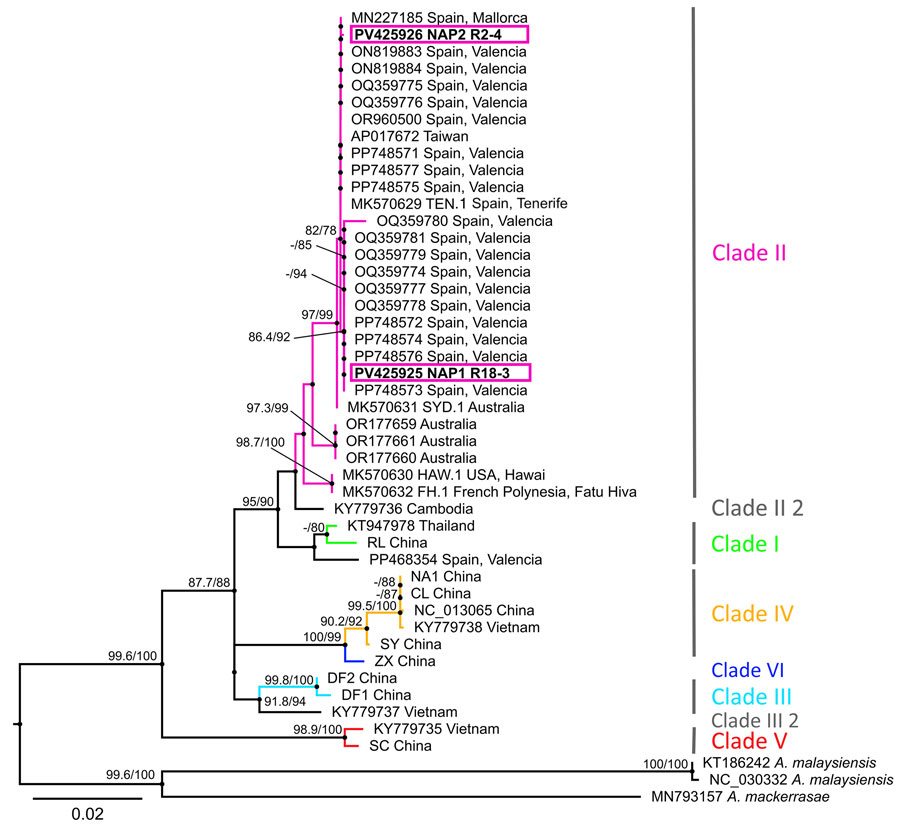Volume 31, Number 9—September 2025
Dispatch
Detection of Rat Lungworm (Angiostrongylus cantonensis) in Rats and Gastropods, Italy
Figure 2

Figure 2. Maximum-likelihood phylogenetic tree of rat lungworm (Angiostrongylus cantonensis) detected in rats and gastropods, Italy. Tree is based on cytochrome c oxidase subunit 1 gene (1,578 bp) and partial sequences (215–561 bp) calculated by a Tamura-Nei plus model in IQ-TREE (http://www.iqtree.org) (9). Labeling of the clades follows previous studies (10). Sequences are labeled by GenBank accession numbers, where available, and locality of origin is indicated. Pink boxes indicate the 2 unique sequences from this study. Numbers at nodes indicate percentage SH-aLRT/ultrafast bootstrap support. Only values >75 are shown. Scale bar indicates nucleotide substitutions per site.
References
- Morgan ER, Modry D, Paredes-Esquivel C, Foronda P, Traversa D. Angiostrongylosis in animals and humans in Europe. Pathogens. 2021;10:1236. DOIPubMedGoogle Scholar
- Alicata JE. Biology and distribution of the rat lungworm, Angiostrongylus cantonensis, and its relationship to eosinophilic meningoencephalitis and other neurological disorders of man and animals. Adv Parasitol. 1965;3:223–48. DOIPubMedGoogle Scholar
- Cowie RH. Biology, systematics, life cycle, and distribution of Angiostrongylus cantonensis, the cause of rat lungworm disease. Hawaii J Med Public Health. 2013;72(Suppl 2):6–9.PubMedGoogle Scholar
- Turck HC, Fox MT, Cowie RH. Paratenic hosts of Angiostrongylus cantonensis and their relation to human neuroangiostrongyliasis globally. One Health. 2022;15:
100426 . DOIPubMedGoogle Scholar - Foronda P, López-González M, Miquel J, Torres J, Segovia M, Abreu-Acosta N, et al. Finding of Parastrongylus cantonensis (Chen, 1935) in Rattus rattus in Tenerife, Canary Islands (Spain). Acta Trop. 2010;114:123–7. DOIPubMedGoogle Scholar
- Paredes-Esquivel C, Sola J, Delgado-Serra S, Puig Riera M, Negre N, Miranda MÁ, et al. Angiostrongylus cantonensis in North African hedgehogs as vertebrate hosts, Mallorca, Spain, October 2018. Euro Surveill. 2019;24:33. DOIPubMedGoogle Scholar
- Galán-Puchades MT, Gómez-Samblás M, Osuna A, Sáez-Durán S, Bueno-Marí R, Fuentes MV. Update on the first finding of the rat lungworm, Angiostrongylus cantonensis, in Rattus spp. in continental Europe, Valencia, Spain, 2022. Pathogens. 2023;12:4. DOIPubMedGoogle Scholar
- Federspiel F, Skovmand S, Skarphedinsson S. Eosinophilic meningitis due to Angiostrongylus cantonensis in Europe. Int J Infect Dis. 2020;93:28–39. DOIPubMedGoogle Scholar
- Trifinopoulos J, Nguyen LT, von Haeseler A, Minh BQ. W-IQ-TREE: a fast online phylogenetic tool for maximum likelihood analysis. Nucleic Acids Res. 2016;44(W1):
W232-5 . DOIPubMedGoogle Scholar - Tian X, Chen S, Duan L, Qian Y, Li H, Lv S. The global spread pattern of rat lungworm based on mitochondrial genetics. Pathogens. 2023;12:13. DOIPubMedGoogle Scholar
- Anettová L, Baláž V, Coufal R, Horsák M, Izquierdo-Rodriguez E, Šipková A, et al. Lizards as sentinels for the distribution of Angiostrongylus cantonensis. Epidemiol Infect. 2024;152:
e168 . DOIPubMedGoogle Scholar - Ansdell V, Kramer KJ, McMillan JK, Gosnell WL, Murphy GS, Meyer BC, et al. Guidelines for the diagnosis and treatment of neuroangiostrongyliasis: updated recommendations. Parasitology. 2021;148:227–33. DOIPubMedGoogle Scholar
- Garijo-Toledo M, Alarcón-Elbal PM, Montero E, Bravo-Barriga D, Sansano-Maestre J, Ahuir-Baraja AE, et al. Mortality associated with Angiostrongylus cantonensis in non-human primates in Europe. Int J Parasitol. 2025;55:427–34. DOIPubMedGoogle Scholar
- Odani J, Sox E, Coleman W, Jha R, Malik R. First documented cases of canine neuroangiostrongyliasis due to Angiostrongylus cantonensis in Hawaii. J Am Anim Hosp Assoc. 2021;57:42–6. DOIPubMedGoogle Scholar
- Cowie RH, Malik R, Morgan ER. Comparative biology of parasitic nematodes in the genus Angiostrongylus and related genera. Adv Parasitol. 2023;121:65–197. DOIPubMedGoogle Scholar
1These first authors contributed equally to this article.
Page created: August 08, 2025
Page updated: August 26, 2025
Page reviewed: August 26, 2025
The conclusions, findings, and opinions expressed by authors contributing to this journal do not necessarily reflect the official position of the U.S. Department of Health and Human Services, the Public Health Service, the Centers for Disease Control and Prevention, or the authors' affiliated institutions. Use of trade names is for identification only and does not imply endorsement by any of the groups named above.